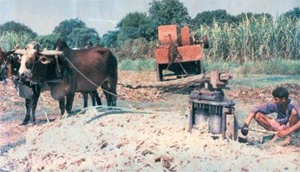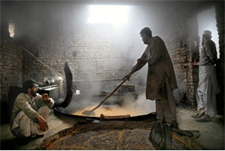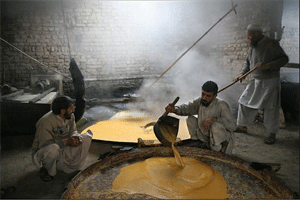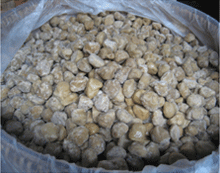Historically when we talk of sugar’s history it is the past
history of raw form of sugar and that was Gur. Therefore it enjoys combined
history till refining of sugar started.
Gur or Jaggery is still produced in Pakistan, India, Bangladesh and
many other countries. It is a traditional product consumed directly in
unrefined condition this type of sugar is a concentrated product of cane
juice without separation of molasses and crystals, and can vary in colour
from golden brown to dark brown.

It contains 50% sucrose, up to 20% invert sugar, moisture content up
to 20% and remainders made up of other insolvable matter such as ash,
protein and bagasse fiber particles.
 Gur is considered as auspicious in many parts
of India, Pakistan’s Northern areas and Afghanistan right up to
CAR neighboring north of Afghanistan. It is an essential food commodity
and source of energy for the human beings and their animals during crucial
winter months of heavy snowfall and blizzards. Its production continues
in Pakistan despite surplus capacity of sugar mills, major chunk of sugarcane
in Peshawar-Mardan valley is consumed in Gur production as it enjoys free
movement and levy of all taxes. Gur is considered as auspicious in many parts
of India, Pakistan’s Northern areas and Afghanistan right up to
CAR neighboring north of Afghanistan. It is an essential food commodity
and source of energy for the human beings and their animals during crucial
winter months of heavy snowfall and blizzards. Its production continues
in Pakistan despite surplus capacity of sugar mills, major chunk of sugarcane
in Peshawar-Mardan valley is consumed in Gur production as it enjoys free
movement and levy of all taxes.
Its large markets in Peshawar Mardan valley are at Shergarh, Mardan,
Charsada and Peshawar. All others districts of Pakistan actively trade
Gur in their respective grain markets.

The method of production of Gur have also improved from past crude methods
of cane roller crushers pulled by oxen in round circle to extract the
cane juice, now run by mechanical means powered by moveable generators
or by hooking unauthorized power cables to the power lines in the vicinity.
The sap is boiled and stirred in large pans fueled by bagasse till the
water content is dried. The lumps of Gur are separated and left to cool
down before bagging.
 As a specialty dry fruit is
added to the boiled sap pans just before cooling and lumps of dry fruit
added Gur are separated for cooling down. As a specialty dry fruit is
added to the boiled sap pans just before cooling and lumps of dry fruit
added Gur are separated for cooling down.
Dry fruit added Gur is most delicious form of Gur gifted to friends and
relations across the country used as dessert, priced high in the market
depending on the quantity and quality of dry fruit added.
The continuation in production of Gur commercially has jeopardized the
procurement of sugarcane by the mills and thus has affected the economics
of sugar production particularly in Khyber Pakhtunkhwa and some areas in Punjab. It
continues to draw a large market due to its taste and its health benefits
as being said in the rural areas. Surprisingly the price of Gur has always
dominated the price of white sugar in the market even being in its raw
form.
(See notification No. PY-19/48 the Gur Control order 1948)
|
